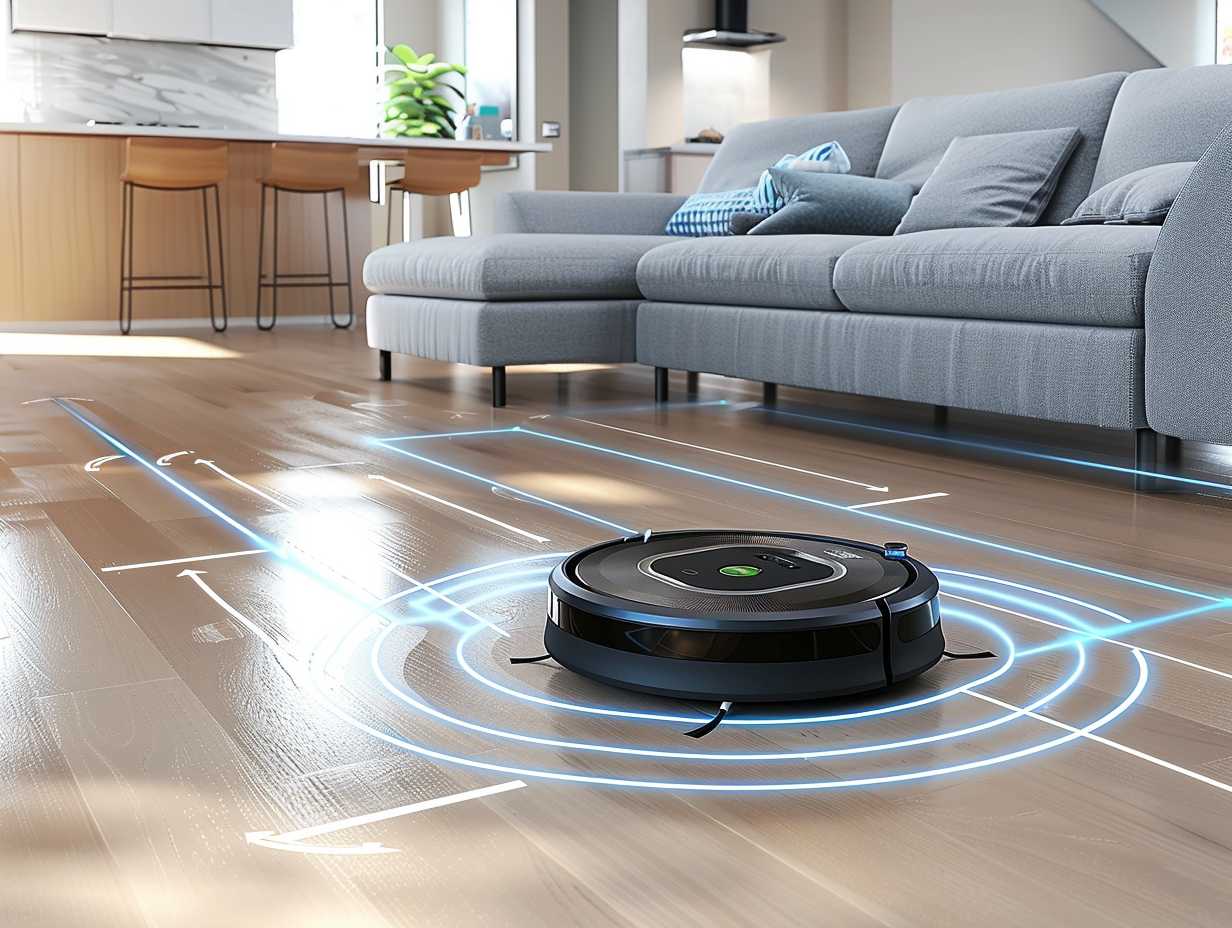
Robot Vacuums and Allergen Reduction

Did you know that indoor air can be up to 5 times more polluted than outdoor air? With the rise in allergies and respiratory issues, finding ways to reduce allergens in your home is essential.
One innovative solution gaining popularity is the use of robot vacuums. These autonomous cleaning devices offer convenience and efficiency in tackling dust, pet dander, and other common allergens.
But how effective are they really in improving indoor air quality? Let’s explore the impact of robot vacuums on allergen reduction and how they compare to traditional vacuum cleaners.
Key Takeaways
- Robot vacuums equipped with strong suction and high-efficiency filters effectively reduce allergens.
- Selecting the right robot vacuum based on specific needs can enhance allergen reduction.
- Regular maintenance, including emptying dustbins and cleaning filters, optimizes allergen capture.
- Integrating robot vacuums into allergy management promotes healthier indoor air quality.
Benefits of Robot Vacuums

If you struggle to find time for thorough cleaning, robot vacuums offer a convenient solution for maintaining a tidy home. These smart devices can save you precious time and effort by autonomously cleaning your floors while you focus on other tasks.
With their compact design, they effortlessly glide under furniture and reach tight spaces that are hard to clean manually. Robot vacuums are equipped with advanced sensors that help them navigate around obstacles and prevent falls down stairs.
Many models also come with scheduling features, allowing you to set cleaning times that suit your daily routine. Embrace the ease and efficiency of robot vacuums to enjoy a consistently clean home without the hassle.
How Robot Vacuums Capture Allergens
Robot vacuums effectively capture allergens, contributing to a healthier indoor environment for you and your family. Here’s how they do it:
-
Powerful Suction: Robot vacuums are equipped with strong suction power that allows them to lift and remove allergens such as dust mites, pet dander, and pollen from carpets and hard floors.
-
High-Efficiency Filters: These vacuums are designed with high-efficiency filters that trap tiny particles as small as 0.3 microns, ensuring that allergens aren’t released back into the air during the cleaning process.
-
Multi-Surface Cleaning: Robot vacuums can navigate through different floor types, ensuring thorough allergen removal from carpets, rugs, hardwood, and tile floors.
Choosing the Right Robot Vacuum

When selecting a robot vacuum, consider your specific cleaning needs and the features that align with them. Think about the size of the area you need to clean, whether you have pets, and if you need specialized brushes for carpets or hardwood floors. Here’s a table summarizing key features to help you choose the right robot vacuum:
| Feature | Description | Benefits |
|---|---|---|
| Navigation System | Mapping technology for efficient cleaning routes | Avoids missing spots |
| Brush Types | Different brushes for various floor types | Effective cleaning on all surfaces |
| Filtration System | HEPA filters for trapping allergens | Improves indoor air quality |
| Battery Life | Longer battery runtime for larger areas | Consistent cleaning without recharging |
| Smart Home Integration | Connectivity with smart devices for remote control | Convenient operation from anywhere |
Maintenance Tips for Allergen Reduction
To effectively reduce allergens in your home, regularly maintaining your robot vacuum is essential. Here are some maintenance tips to ensure optimal allergen reduction:
-
Empty the Dustbin: Regularly emptying the dustbin prevents allergens from recirculating in the air.
-
Clean the Brushes: Check and clean the brushes to remove any hair, debris, or allergens that may have accumulated.
-
Replace Filters: Change the filters as recommended by the manufacturer to maintain efficient allergen capture.
Integrating Robot Vacuums Into Allergy Management

Regularly incorporating your robot vacuum into your allergy management routine can greatly enhance indoor air quality and decrease allergen exposure. By scheduling your robot vacuum to clean frequently, especially in high-traffic or pet-inhabited areas, you can effectively reduce the presence of common allergens like dust mites, pet dander, and pollen.
The automated nature of robot vacuums allows for consistent cleaning without the need for manual effort, ensuring that allergens are continuously being removed from your home environment. Additionally, some robot vacuums are equipped with high-efficiency particulate air (HEPA) filters, which can trap even smaller allergen particles, further improving air quality.
Integrating your robot vacuum into your allergy management strategy can lead to noticeable relief for allergy sufferers and promote a healthier living space.
Frequently Asked Questions
Can Robot Vacuums Effectively Eliminate Pet Dander and Fur From Carpets and Floors?
You’ll find that some robot vacuums can effectively remove pet dander and fur from carpets and floors. They have advanced features like strong suction and specialized brushes that work well in picking up these allergens.
Are There Any Specific Features to Look for in a Robot Vacuum for Reducing Allergens in Homes With Asthma Sufferers?
When choosing a vacuum for asthma sufferers, prioritize HEPA filters, strong suction, and effective sealing. These features help trap allergens and prevent them from recirculating. Regular vacuuming and maintenance are important for reducing asthma triggers in your home.
How Often Should the Filters Be Replaced in a Robot Vacuum to Maintain Optimal Allergen Reduction?
Wondering how often to replace filters for best allergen reduction? Keep in mind that filter replacement frequency varies depending on usage and filter type. Check your vacuum’s manual for specific recommendations to maintain clean air quality.
Can Robot Vacuums Effectively Remove Dust Mites From Mattresses and Upholstery?
To effectively remove dust mites from mattresses and upholstery, regularly vacuuming with a high-powered device is essential. Pay attention to crevices and seams where mites hide. Consider using a vacuum with a HEPA filter for better results.
Are There Any Specific Cleaning Techniques or Products Recommended to Complement the Use of a Robot Vacuum for Allergen Reduction?
When battling allergens, opt for a multipronged approach. Incorporate regular dusting, washing bedding in hot water, and using HEPA filters. These techniques, combined with a robot vacuum, can greatly reduce allergens in your home for improved indoor air quality.
Conclusion
As you watch your robot vacuum glide effortlessly across your floors, imagine it not only picking up dirt and debris, but also capturing allergens that can trigger sneezing and itching.
With the right maintenance and proper use, these robotic helpers can greatly reduce allergens in your home, creating a cleaner and healthier environment for you and your loved ones.
So sit back, relax, and let your robot vacuum work its magic, keeping allergens at bay.
More information about
Affiliate information declaration: We may earn revenue from the products referred on this page and participate in affiliate programs.


